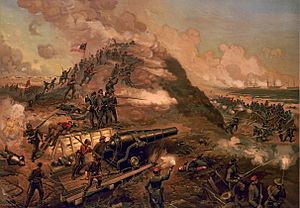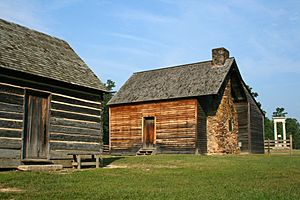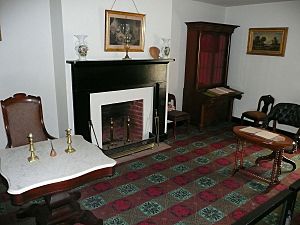Troop engagements of the American Civil War, 1865 facts for kids
This is a list of important battles and small fights from the American Civil War in 1865. This was the final year of the war. During this year, the Union army captured the last big Confederate ports. They also took the Confederate capital city. This led to the surrender of the four main Confederate armies.
Contents
The Final Year of the War: 1865
Battles in the East
In the eastern part of the war, Union forces made a big move. On January 15, a combined army and navy force captured Fort Fisher. This fort was at the mouth of the Cape Fear River. Major General Alfred Terry and Rear Admiral David Dixon Porter led this attack.
Taking Fort Fisher meant that the port of Wilmington, North Carolina was closed. This stopped Confederate ships from getting supplies. The Confederates still held Wilmington to move their supplies out. They also wanted to stop Terry from helping William Tecumseh Sherman's army. Sherman was marching north through the Carolinas.
After fixing Fort Fisher, Terry's forces got more help. Major General John Schofield arrived with the XXIII Corps. Schofield then took charge of all Union actions in North Carolina. He began moving towards Wilmington in mid-February. Terry's troops moved along one side of the river. Schofield's corps, with help from Porter's gunboats, moved along the other side.
On February 19, the Union captured Fort Anderson. This forced the Confederates to leave their defenses south of Wilmington. After a few more small fights, Union forces entered Wilmington on February 22.
The Fall of Petersburg and Richmond
On April 1 and 2, Union forces attacked the Confederate Army of Northern Virginia. These attacks happened near Petersburg, Virginia. Lieutenant General Ulysses S. Grant led the Union army. They broke through the Confederate defenses. They also cut off the supply lines south of the city.
Because of this, General Robert E. Lee had to leave Petersburg and Richmond. This ended the nine-month-long Siege of Petersburg. Lee first moved west, hoping to go south to North Carolina. He wanted to join other Confederate forces there.
Lee's army had a head start. But he had to wait at Amelia Court House. Confederate units from Richmond were slow crossing the Appomattox River. This delay allowed Union cavalry and infantry to get ahead of Lee. They reached Jettersville first. This forced Lee to march even farther west than he planned.
Over the next few days, the Union army kept pushing Lee's forces. They attacked from the south and west. This made Lee retreat further west. Finally, at Appomattox Court House, Grant surrounded Lee. Lee was forced to surrender on April 9.
Sherman's March and Johnston's Surrender
In the Carolinas, Major General William T. Sherman started marching north. He left Savannah, Georgia, in late February. His plan was to meet Grant's armies near Petersburg, Virginia. Sherman's forces pushed the Confederates out of South Carolina. They did this by moving around their sides.
Sherman's army reached North Carolina in early March. It was split into two parts. Henry Warner Slocum and Oliver Otis Howard led these parts. General P. G. T. Beauregard was the Confederate commander in the Carolinas. But Confederate President Jefferson Davis and Robert E. Lee thought he couldn't handle the situation.
On February 22, General Joseph E. Johnston became the new commander. He took charge of all Confederate forces in North Carolina. This included the Army of Tennessee. Johnston gathered his forces near Smithfield. He hoped to attack and defeat one part of Sherman's army. He wanted to do this before the other part arrived.
Johnston attacked in the Battle of Bentonville on March 19. He hit Slocum's part of the army. But the Confederates could not win before Howard's part arrived that evening. Johnston waited at Bentonville for two more days. Then he retreated back to Smithfield.
Sherman joined Schofield's force at Goldsboro on March 23. He then spent three weeks resting his troops. He also fixed the railroad to Wilmington. During this time, Johnston stayed near Smithfield. He also rested and reorganized his army. He talked with Lee and agreed to combine their forces. They hoped to defeat either Sherman or Grant before the Union armies could join.
Sherman started moving against Johnston on April 10. This forced the Confederates to leave Smithfield. They retreated towards Greensboro. The Union army captured Raleigh, the state capital, on April 13. After hearing about Lee's surrender, Johnston also surrendered. He gave up his army and other Confederate forces. This happened at the Bennett Place, North Carolina on April 26.
Battles in the West
In the western part of the war, Major General James H. Wilson led his cavalry. He went on a raid through Alabama and Georgia. This started on March 22. His goal was to destroy Confederate factories. The Confederate commander there was Lieutenant General Nathan Bedford Forrest. He had spread his cavalry out during the winter. This made it hard for him to gather them against Wilson.
On April 1, Forrest gathered his forces in Selma, Alabama. Wilson attacked and defeated him in the Battle of Selma. Wilson then continued east into Georgia.
Around Mobile, Alabama, the last port held by the Confederates, Major General Edward Canby began attacking. He started siege operations against the forts protecting the city on March 31. He captured Spanish Fort on April 8. Then he took Fort Blakely the next day. The Confederates left Mobile without a fight on April 11.
Taking Mobile freed up more Union troops. They could then help Wilson's cavalry in the north. This, along with news of the Confederate surrenders in Virginia and North Carolina, convinced Richard Taylor to surrender. Taylor was the Confederate commander in Alabama, Mississippi, and East Louisiana. He surrendered to Canby at Citronelle, Alabama, on May 4. Forrest surrendered his cavalry on May 9.
The Last Surrenders
News traveled slowly back then. So, Confederate forces in the Trans-Mississippi Theater didn't hear about the surrenders in the east for weeks. The very last organized fight of the war happened at Palmito Ranch, Texas. This was on May 13 and 14. The Confederates actually won this battle.
Confederate Lieutenant General Edmund Kirby Smith surrendered his forces. This happened at Shreveport, Louisiana, on June 2. Confederate forces in the Indian Territory surrendered on June 23.
The Confederate ship CSS Shenandoah was far away. It was in the Pacific Ocean in April and May. The crew only heard the war was over on August 2. A British ship told them. The crew feared being treated as pirates if they surrendered to Union forces. So, the ship sailed to Liverpool, United Kingdom. It surrendered to British authorities on November 6.
Important Fights of 1865
| Date | Battle | Armies Involved | Losses | Result |
|---|---|---|---|---|
| January 13 – 15 | Fort Fisher II, North Carolina | Union Terry's Provisional Corps, Confederate Department of North Carolina | Union 1,207 to 1,627, Confederate 400 to 500 killed and wounded, 1,400 to 1,500 prisoners | Union victory |
| January 16 | Battle of Dove Creek, Texas | Confederate District of Texas, Kickapoo tribe | Confederate 49, Kickapoo unknown | Kickapoo Indian Victory |
| February 2 – 3 | Rivers Bridge, South Carolina | Union Grand Army of the West, Confederate Military Division of the West | Union 92 killed and wounded, Confederate 170 killed and wounded | Union victory |
| February 5–7 | Hatcher's Run, Virginia | Union Army of the Potomac, Confederate Army of Northern Virginia | Union 1,559, Confederate 1,000 | Union victory |
| February 19–20 | Town Creek, N.C. | Union Third Division, XXIII Corps, Confederate infantry brigade | Union unknown, Confederate 395 | |
| February 20 | Forks Road, N.C. | Union Terry's Provisional Corps, Confederate Cape Fear District | Union 53, Confederate unknown | |
| March 2 | Waynesboro, Virginia | Union Army of the Shenandoah, Confederate Army of the Valley District | Union 30, Confederate 1,600 | Union victory |
| March 6 | Battle of Natural Bridge, Florida | Union Department of the Gulf, Confederate volunteers | Union 148, Confederate 25 | Confederate victory |
| March 7–10 | Wyse Fork, North Carolina | Union Grand Army of the West, Confederate Department of North Carolina | Union 1,300, Confederate 1,500 | Tactical Union victory, Strategic Confederate victory |
| March 10 | Monroe's Cross Roads, North Carolina | Union 3rd Cavalry Division, Confederate Hampton's Cavalry command | Union 183, Confederate 86 | Inconclusive |
| March 16 | Averasborogh, North Carolina | Union Grand Army of the West, Confederate Department of South Carolina, Georgia and Florida | Union 683, Confederate 865 | Inconclusive |
| March 19–21 | Bentonville, North Carolina | Union Grand Army of the West, Confederate Army of the South | Union 1,527, Confederate 2,606 | Union victory |
| March 24 | Cox's Bridge, North Carolina | Union X Corps, Confederate Army of the South | Union 14, Confederate unknown | |
| March 25 | Fort Stedman, Virginia | Union Army of the Potomac, Confederate Army of Northern Virginia | Union 1,017, Confederate 2,681 | Union victory |
| March 27 – April 8 | Spanish Fort, Alabama | Union Department of the Gulf, Confederate Department of East Louisiana, Mississippi and Alabama | Union 657, Confederate 741 | Union victory |
| March 29 | Lewis's Farm, Virginia | Union Army of the Potomac, Confederate Army of Northern Virginia | Union 381, Confederate 371 | Union victory |
| March 31 | Dinwiddle Court House, Virginia | Union Army of the Shenendoah, Confederate Army of Northern Virginia | Union 354, Confederate 760 | Confederate victory |
| March 31 | White Oak Road, Virginia | Union V Corps, Army of the Potomac, Confederate Army of Northern Virginia | Union 1,781, Confederate 900 to 1,235 | Union victory |
| March 31 | Johnson County, Tennessee | Union and Confederate irregulars | Union 1, Confederate 15 | |
| April 1 | Five Forks, Virginia | Union Army of the Shenandoah, Confederate Army of Northern Virginia | Union 830, Confederate 3,000 | Union victory |
| April 2–9 | Fort Blakely, Alabama | Union Department of the Gulf, Confederate Department of East Louisiana, Mississippi and Alabama | Union 775, Confederate 3,700 | Union victory |
| April 2 | Selma, Alabama | Union Cavalry Corps, Confederate Forrest's Cavalry Corps | Union 35,9, Confederate 2,700 | Union victory |
| April 2 | Petersburg III, Virginia | Union Armies of the Potomac, the Shenandoah, and the James, Confederate Army of Northern Virginia | Union 3,894, Confederate 4,852 | Union victory |
| April 2 | Sutherland Station, Virginia | Union Army of the Potomac, Confederate Army of Northern Virginia | Union 366, Confederate 600 | Union victory |
| April 3 | Namozine Church, Virginia | Union Army of the Potomac, Confederate Army of Northern Virginia | Union 81, Confederate unknown | Inconclusive |
| April 5 | Amelia Springs, Virginia | Union Army of the Potomac, Confederate Army of Northern Virginia | Union 158, Confederate unknown | Inconclusive |
| April 6 | Sayler's Creek, Virginia | Union Army of the Potomac, Confederate Army of Northern Virginia | Union 1,148, Confederate 7,700 | Union victory |
| April 6 | Rice's Station, Virginia | Union Army of the Potomac, Confederate Army of Northern Virginia | Union 66, Confederate unknown | Union victory |
| April 6–7 | High Bridge, Virginia | Union Army of the Potomac, Confederate Army of Northern Virginia | Union 847, Confederate 100 | Inconclusive |
| April 7 | Cumberland Church, Virginia | Union Army of the Potomac and Confederate Army of Northern Virginia | Union 571, Confederate unknown | Confederate victory |
| April 8 | Appomattox Station, Virginia | Union Army of the Potomac and Confederate Army of Northern Virginia | Union 48, Confederate 1,000 captured unknown killed and wounded | Union victory |
| April 9 | Dingle's Mill, South Carolina | Union expedition, Confederate militia and regulars | Union unknown, Confederate unknown | Union victory |
| April 9 | Appomattox Court House, Virginia | Union Armies of the Potomac, the James, and the Shenandoah, Confederate Army of Northern Virginia | Union 164, Confederate 500 | Decisive Union victory |
| April 10 | Moccasin Creek, North Carolina | Union XX Corps, Confederate Army of Tennessee | Union 7, Confederate unknown | |
| April 12 | Stalling's Station and Swift Creek, North Carolina | Cavalry from Union Military Division of the West, Confederate Army of Tennessee | unknown | |
| April 13 | Morrisville, North Carolina | Cavalry from Union Military Division of the West, Confederate Army of Tennessee | unknown | Union victory |
| April 16 | West Point, Georgia | Union Wilson's Cavalry Corps, Confederate militia and artillerymen | Union 36, Confederate 264 | Union victory |
| April 18 | Boykin's Mill, South Carolina | Union expedition, Confederate militia | Union 2, Confederate unknown | Union victory |
| May 9 | Waynesville, North Carolina | Confederate Thomas' Legion, Union 2nd North Carolina Mounted Rifles | unknown | |
| May 12–13 | Battle of Palmito Ranch, Texas | Union Department of the Gulf, Confederate Department of the Trans-Mississippi | Union 30, Confederate 6-7 | Confederate victory |
| May 26 | Sea of Okhotsk, near Russia | CSS Shenandoah | Capture of Union whaling ship | |
| June 22–23 | Bering Sea, near the coast of Alaska | CSS Shenandoah | Capture of seven U.S. whaling ships | |
| June 26 | Bering Sea, near the coast of Alaska | CSS Shenandoah | Capture of six U.S. whaling ships. | |
| June 28 | East Cape Bay, Alaska | CSS Shenandoah | Capture of eleven U.S. whaling ships |




